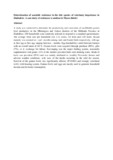Please use this identifier to cite or link to this item:
https://cris.library.msu.ac.zw//handle/11408/1661Full metadata record
| DC Field | Value | Language |
|---|---|---|
| dc.contributor.author | Gono, Robert K. | - |
| dc.contributor.author | Chireshe, Fortune | - |
| dc.date.accessioned | 2016-07-06T08:28:15Z | - |
| dc.date.available | 2016-07-06T08:28:15Z | - |
| dc.date.issued | 2013-01 | - |
| dc.identifier.issn | 2319-7064 | - |
| dc.identifier.uri | https://www.researchgate.net/...Zimbabwe_A_case_study...Zimbabwe/.../00b49523a9 | - |
| dc.identifier.uri | http://hdl.handle.net/11408/1661 | - |
| dc.description.abstract | A study was conducted to determine the productivity and constraints of smallholder guinea fowl production in the Mberengwa and Gokwe districts of the Midlands Province in Zimbabwe. 250 households were randomly selected to respond to a standard questionnaire. The average flock size per household was 1.52 cocks, 5.6 hens and 1.89 keets. Sexual maturity was attained at – and - months among male and female birds respectively, with age at first egg at first egg ranging between – months. Egg hatchability varied between farmers with an overall mean of 64 %. Guinea fowls were acquired through purchase (88%), gifts (7%), or in exchange for labour. Scavenging was the major feeding system, seasonally supplemented with grains. 63% of the farmers provided birds with drinking water. Death of keets was prevalent (89%) and was mainly attributed to possibly Newcastle disease and adverse weather conditions, with most of the deaths occurring in the cold dry season. Survival of the guinea fowls was significantly affected (P<0.001) and strongly correlated (r=0.) with housing system. Guinea fowls and eggs are mainly used to generate household income and for home consumption | en_US |
| dc.language.iso | en | en_US |
| dc.publisher | International Journal of Science and Research | en_US |
| dc.relation.ispartofseries | International Journal of Science and Research;Vol. 2, No. 1 | - |
| dc.subject | Keet,. productivity, smallholder | en_US |
| dc.title | Determination of acaricide resistance in the tick species of veterinary importance in Zimbabwe: a case study of resistance to amitraz in Mazoe district | en_US |
| dc.type | Article | en_US |
| item.grantfulltext | open | - |
| item.fulltext | With Fulltext | - |
| item.languageiso639-1 | en | - |
| item.cerifentitytype | Publications | - |
| item.openairetype | Article | - |
| item.openairecristype | http://purl.org/coar/resource_type/c_18cf | - |
| Appears in Collections: | Research Papers | |
Files in This Item:
| File | Description | Size | Format | |
|---|---|---|---|---|
| Determination of acaricide resistance in the tick species of veterinary importance in Zimbabwe.pdf | Abstract | 186 kB | Adobe PDF |  View/Open |
Page view(s)
122
checked on Dec 7, 2025
Download(s)
24
checked on Dec 7, 2025
Google ScholarTM
Check
Items in MSUIR are protected by copyright, with all rights reserved, unless otherwise indicated.



